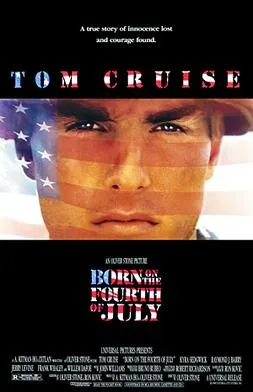Historical accuracy of Born on the Fourth of July

Historical accuracy of Born on the Fourth of July

Characters
Ron Kovic (Tom Cruise)
The film is based directly on Kovic's life and autobiography. Cruise's portrayal was highly praised, and Kovic himself was involved in the film and reportedly gave Cruise his Bronze Star.
Donna (Kyra Sedgwick)
Donna is a composite character, representing young love and the life Kovic might have had, rather than a specific real person from Kovic's life who directly influenced his activism this way.
Charlie (Willem Dafoe)
Charlie is largely considered a fictional composite character, representing the despair and disillusionment Kovic encountered among other disabled veterans in Mexico.
Eli Kovic (Raymond J. Barry)
Based on Ron Kovic's real father, representing the working-class, patriotic family background.
Patricia Kovic (Caroline Kava)
Based on Ron Kovic's real mother, portraying her strong faith and initial difficulty understanding Ron's disillusionment.
Timmy (Frank Whaley)
Likely based on one or more of Kovic's real childhood friends who also served in Vietnam, representing the shared experience and differing paths of veterans.
More characters
Steve Boyer (Jerry Levine)
Likely based on one of Kovic's real childhood friends.
Billy Vorsovich (Stephen Baldwin)
Likely based on one of Kovic's real high school friends.
Legion Commander (Ed Lauter)
Represents the older generation of veterans and established veterans' organizations Kovic initially interacted with.
Ron Kovic (as himself)
The real Ron Kovic appears in a cameo as a wheelchair-bound veteran during the film's opening parade sequence.
Story
Kovic's patriotic upbringing in Massapequa
Accurately reflects Kovic's own description of his strongly patriotic, all-American childhood and his motivations for enlisting in the Marines.
Enlistment in Marines after high school
Kovic did enlist in the U.S. Marine Corps shortly after graduating high school in 1964.
Combat experiences in Vietnam
Based directly on Kovic's accounts, including the chaotic firefight, the accidental killing of a fellow U.S. soldier (Corporal Wilson in the film), and the killing of Vietnamese civilians mistaken for enemy.
Injury causing paralysis (Jan 1968)
Accurately depicts the combat incident where Kovic was shot, resulting in a spinal cord injury that paralyzed him from the mid-chest down.
Conditions in VA hospitals (Bronx VA)
The film's portrayal of neglect, poor sanitation, understaffing, and malfunctioning equipment is based directly on Kovic's horrific experiences detailed in his book and reflects documented issues in VA hospitals of the era.
Struggles with disability, PTSD, alcoholism
Accurately depicts Kovic's immense physical and psychological struggles adapting to his paralysis, dealing with PTSD, impotence, depression, and turning to alcohol.
Time spent with other veterans in Mexico
Kovic did spend time in Mexico ("Villa Dulce") with other disillusioned and disabled veterans, seeking escape, as described in his book.
Transformation into anti-war activist
Accurately portrays Kovic's gradual disillusionment with the war and government, leading him to join Vietnam Veterans Against the War (VVAW) and become a vocal critic.
Protest at 1972 Republican National Convention
Kovic did lead a VVAW protest and spoke out during the convention. The film accurately shows the confrontation, but conflates some violence depicted with incidents that occurred at the Democratic convention.
Speech at 1976 Democratic National Convention
The film accurately culminates with Kovic's real-life speech at the DNC, signifying his prominent role in the anti-war movement.
Confession to family of soldier accidentally killed
This meeting and confession depicted in the film did not happen in real life; it was added by Stone and Kovic for dramatic/emotional resolution in the film narrative.
Relationship with "Donna"
As noted, Donna is a fictional composite character; this specific romantic arc is not based on a real individual relationship central to Kovic's story.
Setting
1950s-60s American Suburbia (Massapequa)
Effectively captures the atmosphere, values, and visual aesthetic of post-war Long Island suburbia where Kovic grew up.
Vietnam War Combat Zones
Portrays the chaotic, dangerous, and morally ambiguous environment of the Vietnam War based on Kovic's experiences, utilizing realistic locations (Philippines stood in for Vietnam).
Veterans Affairs (VA) Hospitals
The grim, under-resourced, and often neglectful conditions depicted are considered an accurate reflection of the reality faced by many veterans in VA facilities at the time.
Late 1960s/Early 1970s USA
Accurately reflects the societal divisions, the growing anti-war movement, counter-culture elements, political tensions, and the often difficult reception veterans received.
College Campuses (Syracuse University)
Captures the atmosphere of student activism and anti-war protests prevalent on American campuses during this period.
Political Conventions (1972 RNC, 1976 DNC)
Recreates the setting and atmosphere of these major political events where Kovic engaged in significant protest actions.
Mexico ("Villa Dulce")
Represents the location where Kovic and other veterans sought refuge, conveying a sense of exile and shared disillusionment.
Period Costumes, Props, and Details
The film generally succeeds in recreating the specific look and feel of the different eras covered, from the late 1950s through the mid-1970s.
